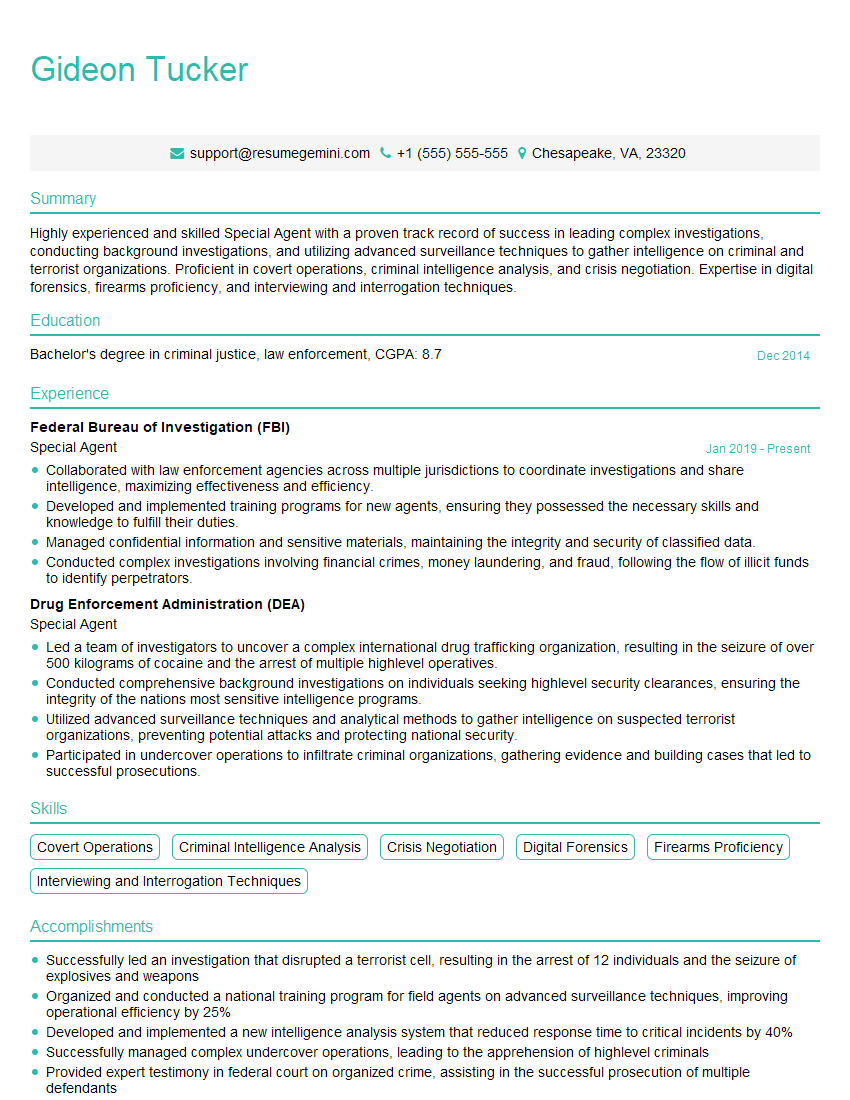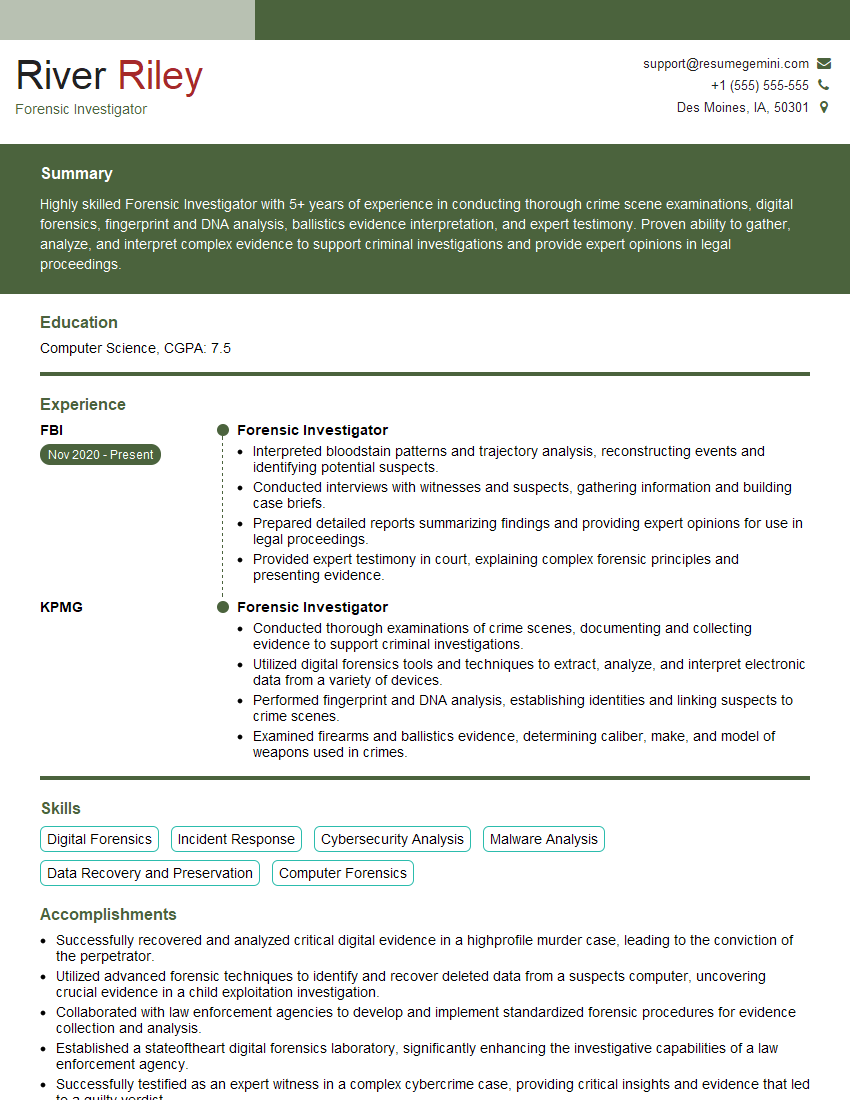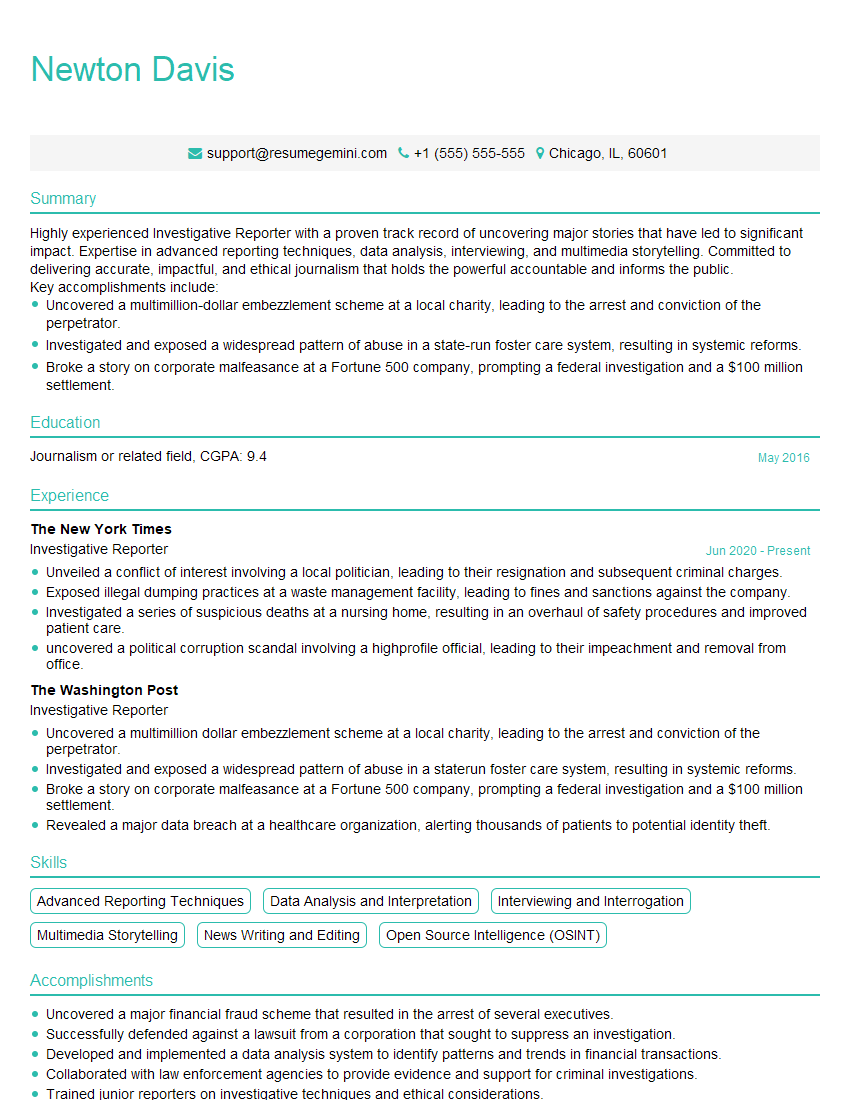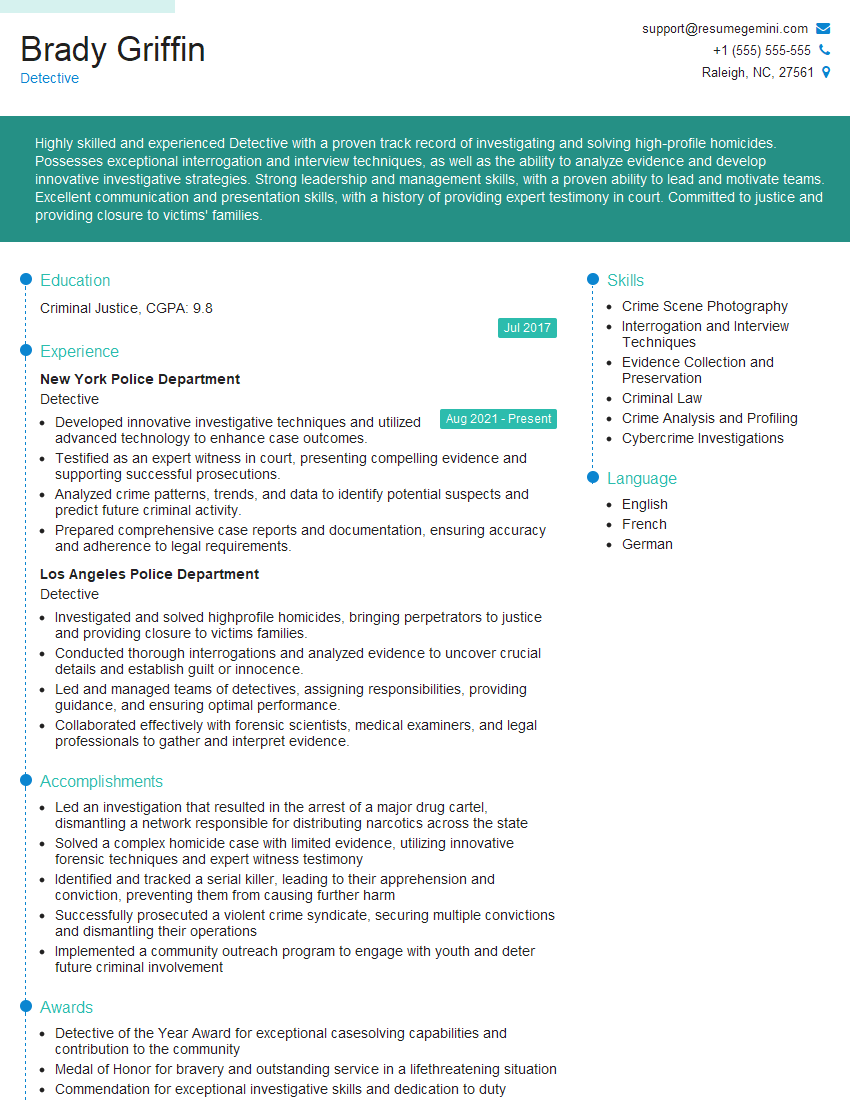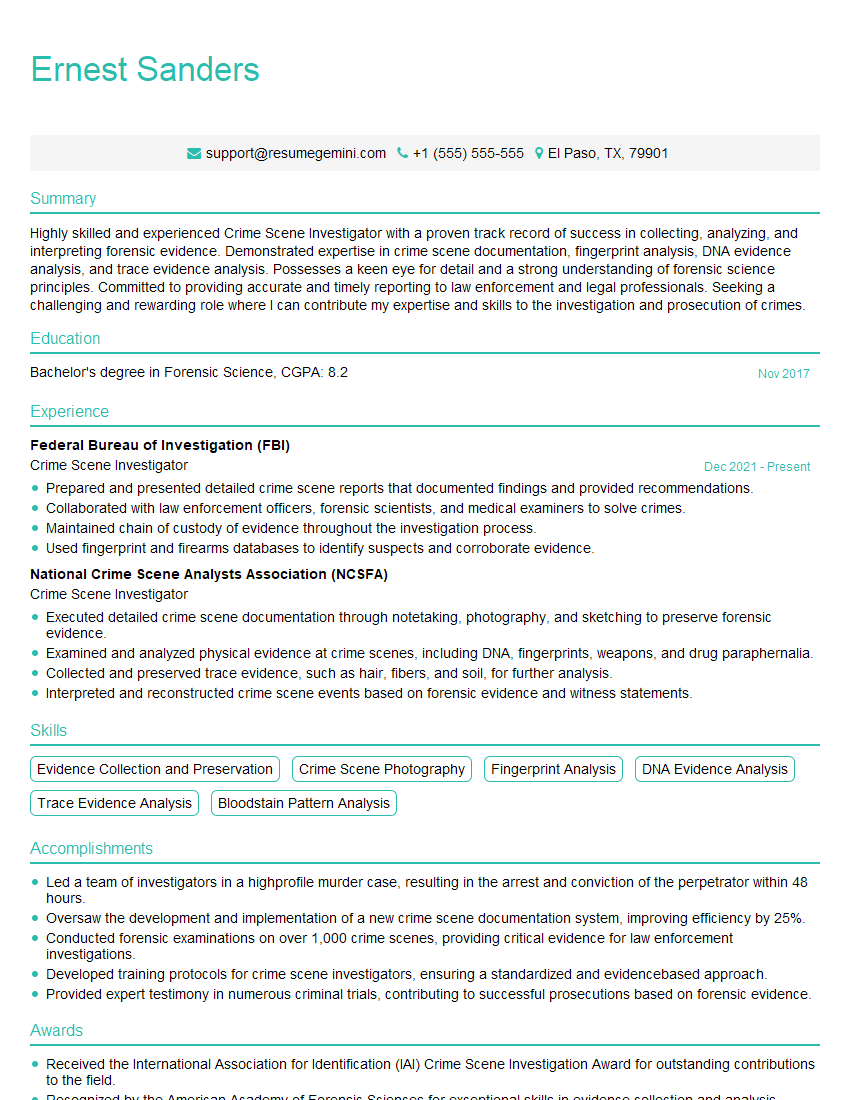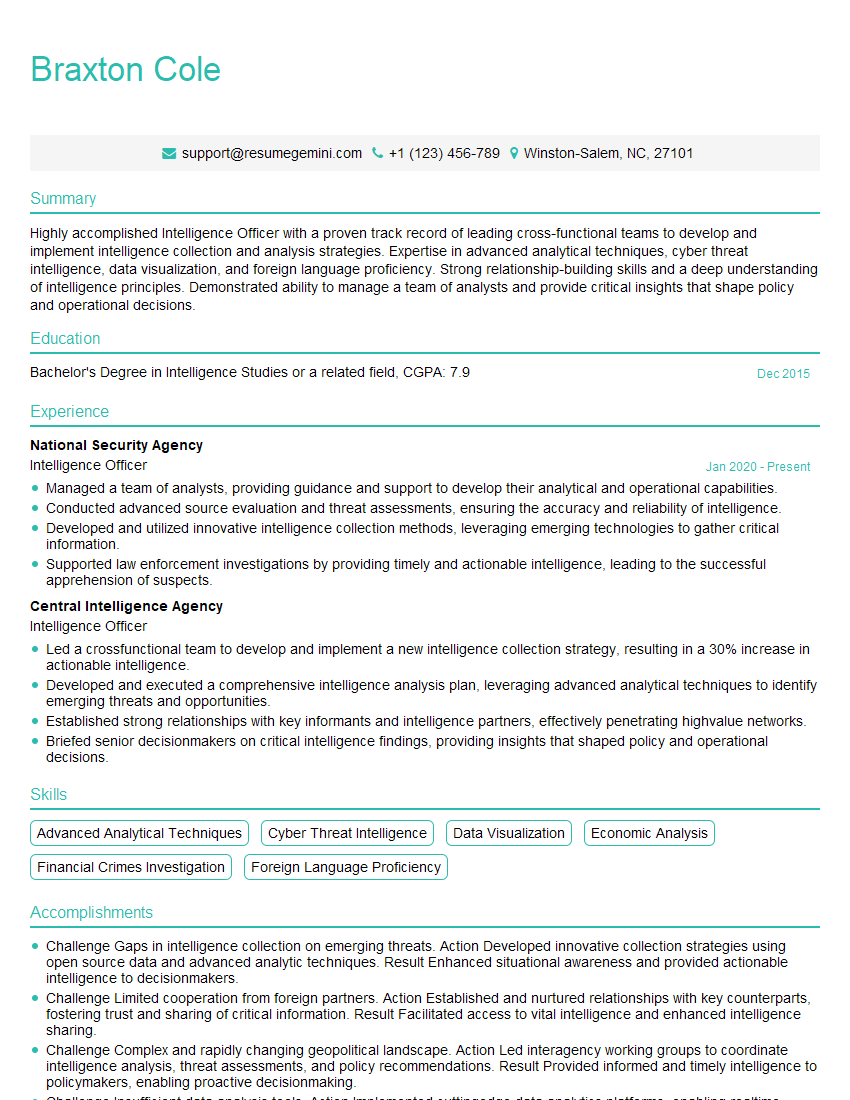Unlock your full potential by mastering the most common Investigation Planning interview questions. This blog offers a deep dive into the critical topics, ensuring you’re not only prepared to answer but to excel. With these insights, you’ll approach your interview with clarity and confidence.
Questions Asked in Investigation Planning Interview
Q 1. Describe your experience in developing investigation plans.
Developing a robust investigation plan is crucial for success. It’s like creating a detailed blueprint for a building; without it, the project is likely to be chaotic and ineffective. My experience encompasses developing plans for a wide range of investigations, from internal fraud to complex cyber security breaches. This involves a thorough understanding of the alleged incident, defining the scope, identifying key objectives, outlining the methodologies, allocating resources, and establishing a timeline. For example, in a case of suspected data theft, the plan would detail steps to secure the affected systems, identify potential entry points, analyze logs, and interview relevant personnel. Another example, in an internal fraud investigation, the plan would clearly define the suspected fraudulent activity, the individuals potentially involved and the necessary steps to gather evidence while ensuring employee rights are respected. I always ensure the plan is flexible and adaptable to accommodate unforeseen developments.
Q 2. How do you prioritize investigative leads and resources?
Prioritizing investigative leads and resources requires a strategic approach. Think of it as a triage system in a hospital – the most critical cases get attention first. I use a risk-based prioritization matrix, considering factors like the potential impact of the issue, the likelihood of success in pursuing a lead, and the availability of resources. Leads are scored based on these criteria, and those with the highest scores are tackled first. Similarly, resource allocation follows the same principle. The most experienced investigators might be assigned to high-priority leads, while junior investigators handle less complex tasks. For example, if we suspect a major security breach, securing the compromised system would be the top priority, followed by analyzing system logs and tracking down the source of the intrusion. This ensures we’re focusing our efforts where they’ll yield the greatest results.
Q 3. Explain your process for identifying and mitigating investigative risks.
Identifying and mitigating investigative risks is paramount. Ignoring risks can lead to compromised investigations, legal issues, or even damage to reputation. My process begins with a thorough risk assessment, identifying potential threats such as data breaches, witness intimidation, or legal challenges. For each identified risk, I develop mitigation strategies. This might involve encrypting sensitive data, implementing security protocols during interviews, or consulting with legal counsel to ensure compliance. For instance, in an investigation involving sensitive employee data, we would implement strict data security measures and obtain legal advice before accessing or sharing any information. Regular risk reviews and adjustments are crucial, as risks can evolve during the course of an investigation. This proactive approach safeguards the integrity of the investigation and protects all involved parties.
Q 4. What methodologies do you use for investigation planning?
My investigation planning utilizes a variety of methodologies, adapting to the specific circumstances of each case. I often employ a combination of techniques, including:
- Timeline Analysis: Creating a chronological sequence of events to establish a clear picture of what happened.
- Hypothesis Testing: Developing and testing multiple hypotheses to explore various possibilities.
- Data Analysis: Using statistical and analytical methods to identify patterns and anomalies in data.
- Interviewing Techniques: Employing structured and unstructured interviewing methods to gather information from witnesses and suspects.
- Evidence Collection and Preservation: Following strict protocols for collecting, preserving, and analyzing evidence.
The choice of methodology depends on the nature of the investigation and the available resources. For instance, in a complex financial fraud case, data analysis techniques would be heavily utilized alongside interviewing key players. While a simple workplace conflict might only require careful interviews and timeline analysis.
Q 5. How do you ensure the legal and ethical compliance of your investigations?
Legal and ethical compliance is non-negotiable. Every investigation I conduct adheres strictly to all relevant laws and regulations, including data protection laws, privacy rights, and employment laws. Before any investigation commences, we obtain necessary legal approvals and ensure all actions comply with established ethical guidelines. This includes obtaining informed consent where required, maintaining confidentiality, and treating all parties with respect and fairness. For example, before interviewing employees, we would inform them of their rights and obtain consent to record the interview. We also regularly consult with legal counsel to ensure our actions remain within legal bounds. This commitment to compliance not only protects the integrity of the investigation but also safeguards the organization and its employees from potential legal liabilities.
Q 6. Describe a time you had to adapt an investigation plan due to unforeseen circumstances.
During an investigation into a suspected software piracy incident, we initially planned to focus on internal users. However, our initial analysis of server logs revealed unauthorized external access. This required a significant shift in our strategy. We immediately adjusted our plan to incorporate external investigation elements, including working with cybersecurity specialists to analyze network traffic and trace the source of the intrusion. We also engaged external legal counsel specializing in intellectual property rights. This adaptability was crucial to the success of the investigation, enabling us to identify the external perpetrator and recover significant losses. This highlights the importance of having a flexible plan that can be adapted based on new information and unforeseen circumstances.
Q 7. How do you document and manage investigative findings?
Meticulous documentation and management of investigative findings are paramount for maintaining transparency, ensuring accountability, and supporting potential legal proceedings. We employ a robust system that includes:
- Detailed Case Files: Each investigation has a dedicated file containing all relevant documents, including interviews transcripts, data analysis reports, and evidence logs.
- Secure Data Storage: All data is stored securely in compliance with relevant data protection regulations. Access is restricted to authorized personnel.
- Version Control: We use version control systems to track changes and ensure the integrity of our findings.
- Chain of Custody: We meticulously document the chain of custody for all physical evidence to maintain its admissibility in any legal proceedings.
- Final Report: A comprehensive final report summarizes the investigation’s findings, conclusions, and recommendations.
This structured approach ensures that investigative findings are accurately documented, readily accessible, and defensible. It also enables a clear audit trail that can be examined if necessary.
Q 8. What software or tools do you utilize for investigation planning?
Investigation planning relies heavily on specialized software and tools to manage the complexity and detail inherent in the process. My toolkit typically includes project management software like Microsoft Project or Jira for task assignments, timeline management, and resource allocation. I also utilize dedicated case management systems, often customized for our organization, to track evidence, interview notes, and investigative findings. These systems ensure a centralized, secure repository for all case-related data. Furthermore, data analysis tools like Tableau or Power BI are invaluable for identifying trends and patterns in large datasets. Finally, mind-mapping software, such as MindManager, assists in visualizing the investigative strategy and identifying interdependencies between various tasks and evidence.
For example, in a recent fraud investigation, Jira helped us track the progress of individual tasks, ensuring each team member knew their responsibilities and deadlines. The dedicated case management system allowed us to securely store and organize thousands of documents, emails, and financial records, maintaining a clear audit trail of our investigative steps.
Q 9. How do you collaborate with other teams during an investigation?
Collaboration is paramount in effective investigation planning. I foster a collaborative environment by using a combination of regular meetings, both in-person and virtual, and shared communication platforms like Slack or Microsoft Teams. These tools allow for real-time updates, quick questions, and the sharing of information across different teams, including legal, IT, human resources, and external consultants. Before initiating an investigation, I define clear roles and responsibilities for each team, ensuring everyone understands their contribution and how their work integrates with the overall plan. Regular communication prevents duplicated efforts and ensures we stay aligned with overall objectives.
For instance, in a data breach investigation, close collaboration with the IT security team was crucial for accessing and analyzing server logs, identifying the source of the breach, and mitigating further damage. Regular communication ensured that all teams were on the same page regarding priorities and deadlines. Transparent communication also helps build trust and ensures that everyone feels heard and valued, which are essential elements for a successful investigation.
Q 10. How do you measure the success of an investigation plan?
Measuring the success of an investigation plan isn’t simply about achieving a conclusion. It involves evaluating its effectiveness across several key metrics. These include the plan’s adherence to the defined budget and timeline, the quality and completeness of the collected evidence, the accuracy of the findings, and the overall impact of the investigation on the organization. For example, a successful investigation might result in the recovery of lost assets, the prevention of future losses, and improvements in internal controls. Quantifiable metrics like the time taken to reach a conclusion, the cost incurred, and the number of leads investigated can also help assess efficiency. Qualitative measures, such as the satisfaction of stakeholders and the quality of the final report, also contribute to the overall evaluation.
We often conduct post-investigation reviews to identify areas for improvement in future plans. This might involve refining our methodology, improving our communication strategies, or investing in new tools and technologies.
Q 11. Explain your understanding of different investigative techniques.
Investigative techniques vary considerably depending on the nature of the investigation. However, some common approaches include interviews, document reviews, forensic analysis, surveillance, and background checks. Interviews are conducted using established techniques to elicit truthful information, ensuring a structured approach that minimizes bias. Document reviews may involve analyzing financial records, emails, or other documents to identify patterns, inconsistencies, or evidence of wrongdoing. Forensic analysis encompasses a range of techniques, such as computer forensics or digital forensics, to extract and analyze data from digital devices. Surveillance, when legally permissible and ethically sound, can provide valuable observational evidence. Background checks are useful for verifying information and identifying potential risks. Each technique must be meticulously documented, following strict chain-of-custody protocols to maintain the integrity of the evidence.
For example, in a workplace theft investigation, we might use interviews to gather statements from employees, review security footage (surveillance), and analyze financial records (document review) to identify the culprit and recover stolen assets. The choice of techniques is always driven by the specific circumstances and legal requirements of the case.
Q 12. How do you handle sensitive information during an investigation?
Handling sensitive information is paramount and requires strict adherence to legal and ethical standards. This involves implementing robust security measures, including access controls, encryption, and secure storage of all data. Only authorized personnel with a legitimate need to access the information are granted access, and their actions are carefully monitored and logged. Furthermore, we adhere to all relevant data privacy regulations, such as GDPR or CCPA, and strictly comply with any legal requirements regarding disclosure. All data is handled in a manner that protects the privacy and confidentiality of individuals.
For instance, in an investigation involving personal medical information, we would ensure the data is encrypted both in transit and at rest, and access is strictly limited to those directly involved in the investigation with appropriate security clearances and training. This involves maintaining detailed audit trails of all data access and disposal.
Q 13. Describe your experience in budget management for investigations.
Budget management is a critical aspect of investigation planning. Before commencing any investigation, I develop a detailed budget that outlines all anticipated costs, including personnel costs, travel expenses, expert fees, and equipment rentals. I track expenses meticulously throughout the investigation, ensuring adherence to the allocated budget. This requires regular monitoring of expenditures against the budget and making necessary adjustments as needed. I use budget tracking software and regularly review the budget status with stakeholders to ensure transparency and to identify potential overruns early on. I always prioritize cost-effectiveness and explore ways to optimize resource utilization without compromising the integrity of the investigation.
For example, in a complex financial fraud investigation, I might negotiate lower rates with expert consultants or utilize less expensive data analysis software to maintain cost efficiency without sacrificing the quality or thoroughness of the investigation.
Q 14. How do you manage timelines and deadlines in complex investigations?
Managing timelines and deadlines in complex investigations necessitates meticulous planning and proactive management. I create a detailed project plan with clear milestones, deadlines, and responsibilities for each team member. This plan incorporates potential delays and includes contingency plans to address unforeseen circumstances. I utilize project management software to track progress against the plan and promptly address any deviations from the schedule. Regular status meetings are crucial to ensure that everyone is on track and to identify any potential roadblocks. Open communication with all stakeholders is vital in ensuring transparency and allowing for collaborative problem-solving.
For example, if a key witness is unexpectedly unavailable, the project plan must be adjusted accordingly. This involves rescheduling interviews, adjusting deadlines, and potentially re-allocating resources to ensure the investigation continues to progress smoothly and efficiently towards a timely conclusion.
Q 15. How do you communicate investigation progress to stakeholders?
Communicating investigation progress effectively is crucial for maintaining stakeholder trust and ensuring alignment. My approach involves a multi-faceted strategy, combining regular updates with tailored communication styles. I utilize a variety of methods depending on the stakeholder and the information’s sensitivity.
- Regular Progress Reports: I provide written reports at predetermined intervals, outlining key milestones achieved, challenges encountered, and the projected timeline. These reports are concise, focusing on key findings and their implications.
- Targeted Briefings: For key stakeholders, I conduct briefings, allowing for interactive discussions and the opportunity to address specific concerns. These briefings can be tailored to the technical expertise of the audience.
- Visualizations: Where appropriate, I use charts, graphs, and timelines to present data in an easily digestible format. For instance, a Gantt chart can effectively visualize the investigation’s timeline and task completion.
- Communication Channels: I select the most appropriate channel – email, secure messaging platforms, or in-person meetings – depending on the urgency and sensitivity of the information.
For example, in a recent internal fraud investigation, I used weekly email updates for the majority of the team, supplemented by bi-weekly in-person briefings for senior management and the legal team. This ensured everyone was informed appropriately.
Career Expert Tips:
- Ace those interviews! Prepare effectively by reviewing the Top 50 Most Common Interview Questions on ResumeGemini.
- Navigate your job search with confidence! Explore a wide range of Career Tips on ResumeGemini. Learn about common challenges and recommendations to overcome them.
- Craft the perfect resume! Master the Art of Resume Writing with ResumeGemini’s guide. Showcase your unique qualifications and achievements effectively.
- Don’t miss out on holiday savings! Build your dream resume with ResumeGemini’s ATS optimized templates.
Q 16. How do you identify potential conflicts of interest in an investigation?
Identifying potential conflicts of interest is paramount to maintaining the integrity of an investigation. My approach is proactive and multi-layered.
- Disclosure Statements: At the outset, all investigators and key personnel are required to complete detailed disclosure statements, revealing any potential conflicts, including financial interests, personal relationships, or prior involvement with individuals or entities under investigation.
- Background Checks: Thorough background checks on all involved parties are conducted to uncover any hidden conflicts. This often involves reviewing public records and conducting interviews.
- Ongoing Monitoring: Throughout the investigation, I maintain vigilance for any emerging conflicts. This requires continuous assessment of the information gathered and the relationships between individuals involved.
- Recusal Policy: If a potential conflict is identified, a clear recusal policy is strictly followed, ensuring the impartial conduct of the investigation. The individual with the conflict is removed from the investigation team.
For instance, if an investigator had a close family relationship with a suspect, that investigator would be immediately recused from the investigation to prevent bias and ensure objectivity.
Q 17. Describe your experience in conducting interviews as part of an investigation.
Conducting interviews is a critical part of my investigative process. My approach is structured, yet flexible, to ensure both comprehensive data collection and witness comfort.
- Preparation: Before each interview, I thoroughly review all available evidence and prepare a structured interview plan, including key questions and potential follow-up inquiries. I also adapt the interview approach based on the interviewee’s profile and communication style.
- Building Rapport: I begin by establishing rapport with the interviewee, creating a safe and comfortable environment for open communication. This involves clearly explaining the purpose of the interview and ensuring their understanding of their rights.
- Active Listening: I utilize active listening techniques to fully understand the interviewee’s responses, clarifying ambiguities and probing for deeper insights. Note-taking is thorough and precise, and I often record the interview with the interviewee’s consent.
- Evidence Gathering: I gather evidence systematically, corroborating statements with other sources wherever possible. Any inconsistencies or contradictions are carefully noted and investigated further.
In one case, I interviewed a hesitant witness who initially withheld key information. By carefully building rapport and demonstrating empathy, I eventually gained their trust, and they provided crucial evidence that proved vital to the investigation’s success.
Q 18. How do you ensure the accuracy and completeness of investigative data?
Ensuring data accuracy and completeness is essential for the validity of any investigation. My approach incorporates several key strategies:
- Data Validation: I cross-reference information from multiple sources, comparing statements, documents, and digital records to verify their consistency and accuracy. Discrepancies are investigated thoroughly.
- Chain of Custody: For physical evidence, a meticulous chain of custody is maintained, documenting every step of its handling and storage to prevent contamination or tampering.
- Data Integrity: Digital evidence is secured using forensic techniques, ensuring its authenticity and preventing alteration. Hashes are generated to confirm data integrity.
- Documentation: Every step of the data collection and analysis process is meticulously documented, including sources, methods, and any limitations.
For example, in a cyber security investigation, maintaining a chain of custody for forensic images of hard drives is crucial to ensuring admissibility of the evidence in court. Any deviation from the established procedures would compromise the integrity of the evidence.
Q 19. How do you deal with resistance or obstruction during an investigation?
Resistance or obstruction during an investigation can significantly hamper progress. I address such situations with a combination of legal and strategic approaches.
- Legal Counsel: I consult with legal counsel to ensure all actions comply with relevant laws and regulations. Legal advice is vital when dealing with potential obstruction of justice.
- Escalation Procedures: If resistance continues, I follow established escalation procedures, reporting the obstruction to appropriate authorities.
- Negotiation and Persuasion: I attempt to negotiate with resistant parties, explaining the importance of cooperation and the consequences of non-compliance. A clear understanding of their concerns is crucial.
- Documentation: I meticulously document all instances of resistance and obstruction, including dates, times, individuals involved, and any evidence of non-compliance.
In a previous investigation, a key individual initially refused to cooperate. By carefully documenting their resistance and consulting with legal counsel, we obtained a court order compelling their cooperation. This eventually yielded crucial information.
Q 20. Describe your experience in presenting investigative findings.
Presenting investigative findings requires clarity, conciseness, and compelling evidence. My approach involves careful preparation and a tailored presentation style.
- Executive Summary: I begin with a concise executive summary highlighting the key findings, conclusions, and recommendations. This provides a quick overview for busy stakeholders.
- Logical Structure: I present the findings in a logical and coherent manner, using a clear structure that guides the audience through the investigation’s key stages and evidence.
- Visual Aids: I use charts, graphs, and other visual aids to present data effectively, making complex information easily digestible.
- Q&A Session: I allocate time for a Q&A session to address any questions or concerns from the audience. This demonstrates transparency and facilitates open discussion.
For example, when presenting findings to a board of directors, I use a presentation focusing on the financial implications of the findings and offer recommendations for preventive measures. For a technical audience, I might use a more detailed report with technical data and analysis.
Q 21. How do you maintain objectivity and impartiality during an investigation?
Maintaining objectivity and impartiality is crucial to the credibility of any investigation. My approach focuses on several key principles.
- Structured Methodology: I follow a well-defined investigative methodology, ensuring consistency and minimizing bias. This includes standardized procedures for data collection, analysis, and reporting.
- Evidence-Based Approach: All conclusions are based solely on verifiable evidence, avoiding speculation or assumptions. All evidence is carefully evaluated and scrutinized.
- Conflict of Interest Management: As discussed previously, I proactively identify and manage any potential conflicts of interest, ensuring impartiality.
- Peer Review: Where feasible, I utilize peer review to ensure the objectivity and rigor of my analysis. This provides an additional layer of scrutiny and validation.
Imagine investigating a workplace harassment claim. My objectivity is maintained by thoroughly reviewing all evidence, interviewing all relevant parties, and not allowing my personal feelings or beliefs to influence my analysis and conclusions.
Q 22. How do you stay current with best practices and legal requirements in investigations?
Staying current in investigations requires a multi-pronged approach. It’s not enough to rely on past knowledge; the legal landscape and best practices are constantly evolving. I maintain currency through several key strategies:
- Continuous Professional Development: I regularly attend seminars, webinars, and conferences focused on investigation techniques, legal updates, and emerging technologies. This allows me to learn about new methodologies and legal precedents directly from experts.
- Professional Associations: Membership in relevant professional organizations provides access to journals, publications, and networking opportunities that keep me abreast of the latest developments. These associations often host training sessions and offer certifications to maintain competency.
- Legal Research: I actively monitor changes in relevant legislation, case law, and regulatory updates through legal databases and subscriptions to legal news sources. This ensures I’m aware of any shifts in admissible evidence or investigative procedures.
- Online Resources and Publications: I regularly consult reputable online resources, industry publications, and academic journals to stay informed about new research, best practices, and emerging threats. This includes staying up-to-date on forensic technology advancements.
- Mentorship and Peer Networking: Discussions with colleagues and mentors provide invaluable insights and perspectives on real-world challenges and best practices. Sharing knowledge and experiences is crucial for professional growth.
For example, recently I participated in a workshop on the implications of GDPR and CCPA on cross-border investigations, allowing me to update my procedures to ensure compliance. This proactive approach guarantees my investigative practices remain ethical, legal, and highly effective.
Q 23. Explain your understanding of chain of custody procedures.
Chain of custody refers to the meticulous documentation that tracks the movement and handling of evidence from the moment it’s collected until it’s presented in court. Maintaining an unbroken chain of custody is critical to ensure the evidence’s authenticity and admissibility. A compromised chain of custody can render evidence inadmissible, jeopardizing an entire investigation.
The process involves:
- Secure Collection: Evidence is collected using proper techniques to avoid contamination or alteration, often documented with photos and videos.
- Detailed Logging: Each individual who handles the evidence must be documented, along with the date, time, location, and reason for handling. This is usually recorded in a chain of custody form or a digital log.
- Secure Storage: Evidence is stored in a secure location to prevent tampering or loss. This might involve locked rooms, evidence bags, or secure digital storage with access controls.
- Transportation: Transportation of evidence is also documented, with details of the method and individuals involved.
- Transfer Documentation: Every transfer of evidence must be documented, including signatures from the transferring and receiving individuals.
Imagine a scenario where a stolen laptop is recovered. Every person who touches that laptop – the officer who recovered it, the technician who analyzed it, the evidence custodian – must be accounted for, and their actions documented. Any gap in this chain can cast doubt on the evidence’s integrity.
Q 24. Describe your experience in using data analysis techniques in investigations.
Data analysis plays a vital role in modern investigations. My experience encompasses a range of techniques to extract actionable insights from various data sources. This includes:
- Data Mining: I use data mining techniques to identify patterns, anomalies, and correlations within large datasets, such as financial transactions, communication logs, or network traffic. This can uncover hidden connections and leads that might otherwise be missed.
- Statistical Analysis: Statistical methods are employed to assess the significance of findings and draw robust conclusions. This might involve calculating probabilities, analyzing distributions, or performing hypothesis testing.
- Network Analysis: For investigations involving individuals or organizations, network analysis can visualize relationships and identify key players, facilitating the identification of potential suspects or accomplices.
- Timeline Analysis: I use data analysis to create detailed timelines of events, helping to establish sequences and identify inconsistencies or gaps in narratives.
For instance, in a financial fraud investigation, I utilized data mining to identify unusual transactions that ultimately led to the exposure of a sophisticated money laundering scheme. The analysis helped pinpoint specific individuals and their roles in the fraud.
Q 25. How do you utilize technology to enhance investigation efficiency?
Technology significantly enhances investigation efficiency and effectiveness. I leverage a variety of tools including:
- Case Management Software: This helps organize evidence, track tasks, and manage communication within the investigation team, ensuring a structured and efficient workflow.
- Forensic Software: Tools like EnCase or FTK aid in the recovery and analysis of digital evidence from computers, mobile devices, and other storage media.
- Data Visualization Tools: Tools like Tableau or Power BI allow for the creation of compelling visuals to present complex data findings to stakeholders in an easily understandable format.
- Communication and Collaboration Platforms: Secure platforms like Slack or Microsoft Teams facilitate seamless communication and collaboration among team members, experts, and external stakeholders.
- Geospatial Technology: Mapping software can visually represent locations, movements, and events, providing context and facilitating pattern identification.
For example, in a cybercrime investigation, forensic software allowed us to recover deleted emails and chat logs from the suspect’s computer, providing crucial evidence. Case management software kept the entire investigation organized and ensured all evidence was properly tracked and documented.
Q 26. How do you handle unexpected challenges or obstacles during an investigation?
Unexpected challenges are inevitable in investigations. My approach to handling them involves:
- Adaptability and Flexibility: I maintain a flexible approach, adjusting the investigation plan as necessary to accommodate unforeseen circumstances or new information. Rigidity is the enemy of effective investigation.
- Problem-Solving: I employ structured problem-solving methodologies to analyze obstacles, identify potential solutions, and develop contingency plans. This often involves brainstorming with team members and consulting experts.
- Resource Management: I effectively manage available resources, including time, personnel, and budget, to address unforeseen challenges efficiently. This may involve prioritizing tasks and re-allocating resources as needed.
- Communication and Collaboration: Open communication with stakeholders is essential to manage expectations and address concerns arising from unexpected challenges. Collaboration with other teams or experts may be necessary.
- Documentation: Meticulous documentation of all challenges, solutions, and decisions ensures transparency and facilitates the learning process for future investigations.
For example, I once encountered a situation where a key witness unexpectedly became unavailable. We adapted by re-prioritizing interviews, focusing on securing alternative evidence, and ultimately still achieved our investigative goals.
Q 27. Explain your understanding of different types of evidence and their admissibility.
Understanding the different types of evidence and their admissibility is crucial. Evidence must be relevant, reliable, and legally obtained to be admissible in court. Common types include:
- Testimonial Evidence: Statements made by witnesses under oath.
- Documentary Evidence: Written documents, records, photographs, videos, and other tangible items.
- Real Evidence: Physical objects directly involved in the event under investigation (e.g., a weapon, stolen goods).
- Digital Evidence: Data stored on computers, mobile devices, or other digital media.
- Circumstantial Evidence: Indirect evidence that implies a fact but doesn’t directly prove it.
Admissibility depends on several factors, including:
- Relevance: The evidence must be pertinent to the case.
- Authenticity: The evidence must be genuine and not fabricated.
- Competence: The evidence must be obtained through proper procedures, and the chain of custody must be maintained.
- Hearsay Rule: Generally, out-of-court statements offered to prove the truth of the matter asserted are inadmissible unless an exception applies.
For example, while a witness’s testimony is crucial, it must be reliable and not based on hearsay. Digital evidence requires proper forensic procedures to ensure its authenticity and integrity before it can be admitted. Each type of evidence must meet specific legal standards for admissibility.
Q 28. How do you create a timeline of events during an investigation?
Creating an accurate timeline of events is vital for understanding the sequence of actions and identifying discrepancies. My approach involves:
- Gathering Information: I collect data from various sources, including witness statements, documents, electronic records, and physical evidence.
- Organizing Data: I organize the gathered data chronologically, noting the date, time, and location of each event.
- Identifying Key Events: I identify the most significant events, focusing on those directly related to the matter under investigation.
- Verifying Information: I verify the accuracy of the information collected by corroborating it with multiple sources.
- Visual Representation: I often use a timeline visualization tool or software to represent the timeline graphically, making it easy to understand and communicate.
This might involve using software specifically designed for timeline creation, or simply using a spreadsheet program to organize information. The timeline helps to identify gaps in information, inconsistencies in narratives, and potential areas for further investigation. For example, in a missing person case, a meticulously crafted timeline could highlight the victim’s last known movements, potentially leading to crucial clues for investigators.
Key Topics to Learn for Investigation Planning Interview
- Investigative methodologies: Understanding various approaches like inductive, deductive, and abductive reasoning, and their application in different investigative scenarios.
- Resource allocation and prioritization: Practical application involves outlining how you would allocate limited resources (time, personnel, budget) to maximize efficiency and effectiveness in an investigation. Consider case studies and hypothetical scenarios.
- Risk assessment and mitigation: Developing strategies to identify potential risks and challenges throughout the investigative process and formulating plans to mitigate these risks. This includes considering legal and ethical implications.
- Evidence gathering and analysis: Understanding legal and ethical considerations surrounding evidence collection and analysis. Practical application includes discussing methods for preserving chain of custody and ensuring the integrity of evidence.
- Report writing and communication: Constructing clear, concise, and accurate reports that effectively communicate findings and support conclusions. This involves mastering different reporting styles and adapting communication to various audiences.
- Collaboration and teamwork: Demonstrate an understanding of how to effectively collaborate with diverse teams, including law enforcement, legal professionals, and other stakeholders.
- Technology in investigation planning: Exploring the use of various technologies to enhance investigation efficiency and effectiveness, such as data analysis tools and investigative software.
- Ethical considerations in investigation planning: Understanding and applying ethical principles and legal frameworks throughout the entire investigative process.
Next Steps
Mastering Investigation Planning is crucial for career advancement in this dynamic field. A strong understanding of these concepts will significantly enhance your interview performance and open doors to exciting opportunities. To further improve your job prospects, creating a compelling and ATS-friendly resume is paramount. We strongly recommend leveraging ResumeGemini, a trusted resource for building professional resumes, to showcase your skills and experience effectively. Examples of resumes tailored to Investigation Planning are available to help guide you.
Explore more articles
Users Rating of Our Blogs
Share Your Experience
We value your feedback! Please rate our content and share your thoughts (optional).
What Readers Say About Our Blog
Hi, I’m Jay, we have a few potential clients that are interested in your services, thought you might be a good fit. I’d love to talk about the details, when do you have time to talk?
Best,
Jay
Founder | CEO





